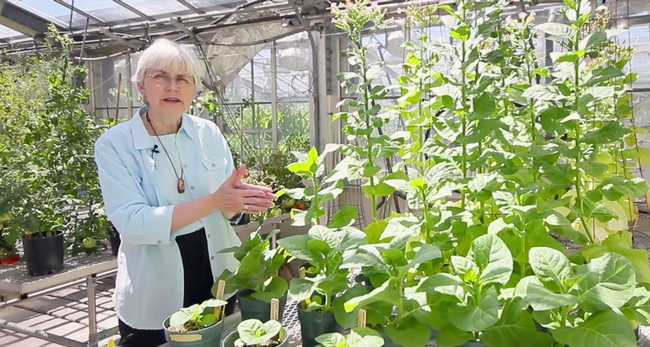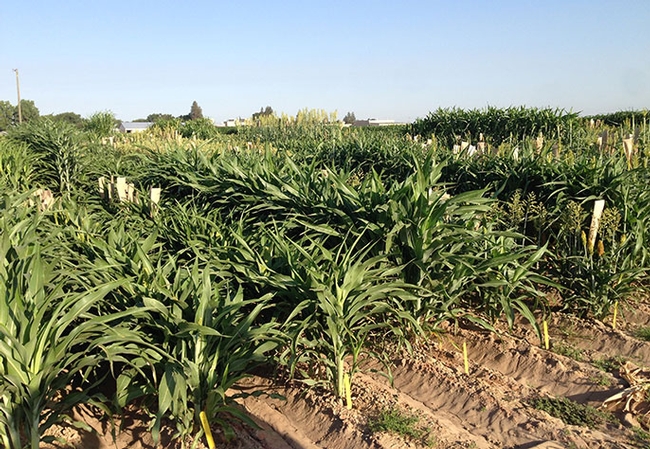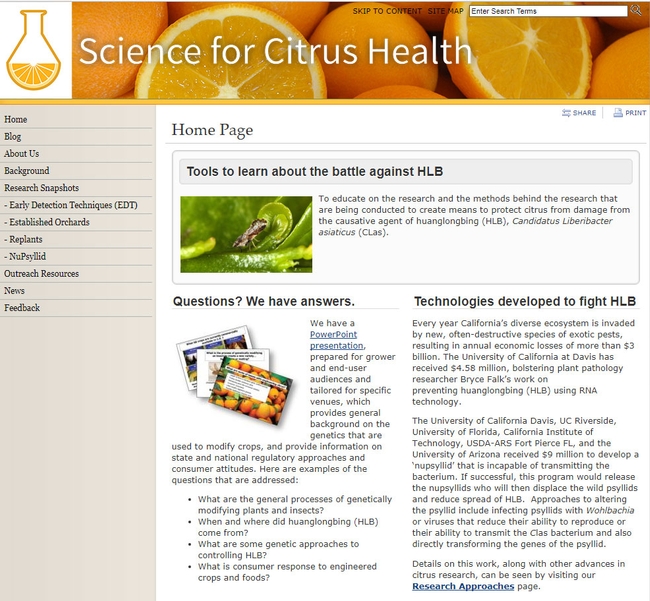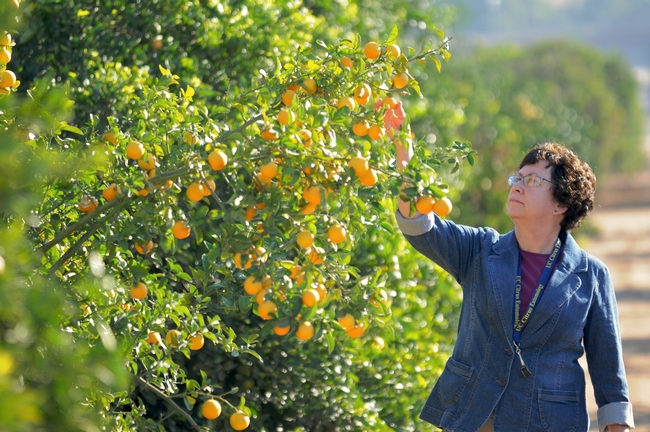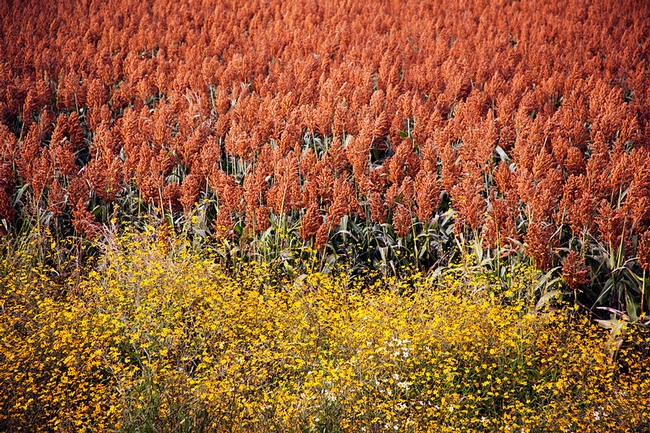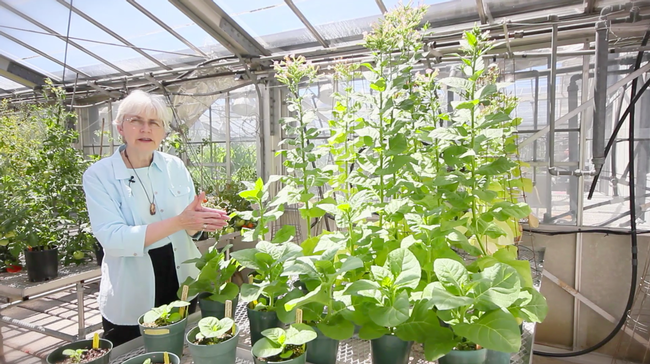Posts Tagged: Peggy Lemaux
Scientists brew up a new way to reach the public
A group of UC graduate students, led by UC Cooperative Extension biotechnology specialist Peggy Lemaux, is making science more accessible to the public by hosting nighttime lectures at Bay Area beer pubs, reported Nicholas Iovino of Courthouse News Service. The monthly talks have tackled topics ranging from microbial bacteria to the search for extraterrestrial life.
The PubScience lecture series grew out of an initiative at UC Berkeley called the Communication, Literacy and Education for Agricultural Research (CLEAR) project. Lemaux launched the project three years ago with a $103,000 grant from the UC Global Food Initiative. CLEAR reaches out to students, members of the community and policymakers.
“If we're not telling people about what we're doing and why they should care, then it's going to be really easy to cut funding for science,” Lemaux said.
The CLEAR group has grown exponentially since its inception. Lemaux believes the election of President Donald Trump and the policies that stem from his administration's denial of climate change helped spark a renewed interest in communicating science to the public.
“The group was much smaller before Trump was elected,” Lemaux said. “Seeing the rise of political extremism driven by misunderstanding of science was a huge factor.”
Microbes associated with plant roots could be a key to helping plants survive drought
As sorghum plants cope with drought conditions, the plants' roots and adjoining microbial communities are communicating in a chemical language that appears to improve the plants' chances under water stress.
“It's amazing,” said Peggy Lemaux, UC Cooperative Extension specialist. “We know there are lots of microbes in the soil and, for the most part, ones in the surrounding soil stayed the same under drought conditions. We only saw changes in those microbes closely associated with the roots.”
The role of drought in restructuring the root microbiome was the first published discovery to come out of a sweeping drought research project underway since 2015 in the fields at UC Kearney Research and Extension Center in Parlier. The five-year study, funded with a $12.3 million grant from the Department of Energy, aims to tease out the genetics of drought tolerance in sorghum and its associated microbes. Using sorghum as a model, scientists hope the research will help them understand and improve drought tolerance in other crops as well.
The new research results from the lab of USDA's Devin Coleman-Derr at UC Berkeley, published April 16, 2018, in the Proceedings of the National Academy of Sciences, document the fate of microbes associated with sorghum roots under three distinct irrigation regimens. Because the San Joaquin Valley generally sees no rain during the growing season, it is the ideal place to mimic drought conditions by withholding irrigation water.
All plots received a pre-plant irrigation to initiate growth. In the control plots, sorghum was irrigated normally, with weekly watering through the season. In the plot simulating pre-flowering drought stress, the plants received no additional water until flowering, about halfway through the season. The third treatment was watered normally until it flowered, and then water was cut off for the rest of the season.
Beginning when the plants emerged, the scientists collected samples from each plot on the same day and time each week for 17 weeks. In a mini, in-field laboratory, roots, rhizosphere (zone surrounding the root), leaves and soil samples from 10 plants in each plot were immediately frozen and transported to Berkeley, where they were disseminated to collaborators, who investigated the plant and microbial responses at the molecular level.
“When a sorghum plant is subjected to drought, it starts sloughing off metabolites, nutrients and amino acids from the roots. The compounds appear to communicate to the neighboring microbial community that the plant is under stress,” Lemaux said. “That selects out a certain population of microbes. Certain types of microbes increase, others go away. When you add water back, the microbial community returns to its pre-drought population in just a few days.”
The researchers cultured two specific microbes that were enriched in the rootzone under drought conditions. They coated sorghum seeds with the microbes and planted them under drought conditions in a growth chamber. This treatment encouraged the plant to grow more roots.
“The microbes appear to improve plant growth during drought,” Lemaux said. “Those microbes appear to be helping plants survive drought. We didn't know that was happening before we got these results.”
Lemaux said the research might lead to future field use of the research breakthrough.
“A lot of companies are interested in the microbiome,” she said. “Some are already selling microbes to coat seeds.”
UC puts high science online in easy-to-read citrus research updates
California citrus farmers have their ears perked for all news related to Asian citrus psyllid (ACP) and huanglongbing (HLB) disease, but the very latest advances have been available only in highly technical research journals, often by subscription only.
UC Cooperative Extension scientists are now translating the high science into readable summaries and posting them on a new website called Science for Citrus Health to inform farmers, the media and interested members of the public.
“The future of the California citrus depends on scientists finding a solution to this pest and disease before they destroy the industry,” said Beth Grafton-Cardwell, UC Cooperative Extension citrus entomology specialist. “Our farmers want to stay on top of all the efforts to stop this threat.”
Grafton-Cardwell and UC Cooperative Extension biotechnology specialist Peggy Lemaux are the two scientists behind the new website. When scientists make progress toward their goals, Grafton-Cardwell and Lemaux craft one-page summaries with graphics and pictures to provide readers with the basics.
For example, the website outlines scientific endeavors aimed at stopping the spread of huanglongbing disease by eliminating the psyllid's ability to transfer the bacterial infection. This section is titled NuPsyllid, and contains summaries of three research papers including one by UC Davis plant pathologist Bryce Falk.
Falk is collecting viruses found in Asian citrus psyllid; so far he has identified five. He is looking into the potential to utilize one of the viruses as is or modify one of the viruses to block the psyllid's ability to transmit the bacterium. For example, the virus might out compete the bacterium in the psyllid's body.
Another focus of the website is HLB early detection techniques (EDTs). If HLB-infected trees are found and destroyed before they show symptoms, ACP is less likely to spread the disease to other trees. EDT research described on the website includes efforts to detect subtle changes in the tree that take place soon after infection, such as alterations in the scents that waft from the tree (studied by UC Davis engineer Cristina Davis), changes in the proteins in the tree (studied by UC Davis food scientist Carolyn Slupsky) and starch accumulation in the leaves (studied by UC farm advisor Ali Pourreza).
Other research areas on the Science for Citrus Health website are solutions for established orchards and replants.
As more research is published, more one-page descriptions will be added to the website. The website contains a feedback form to comment on the science and the summaries.
Science and public opinion square off in GMO debate
Van Eenenaam examined 20 years of records on the health and production of livestock populations eating GMO feed and has not found any measurable trends or changes.
"And those field observations agree with the many hundreds of carefully controlled studies that have been done by researchers globally," she said.
Van Eenennaam confirmed that crops modified to resist herbicides have encouraged greater use of herbicides and some weeds have become resistant to herbicides as a result.
"But I would argue that the trade-offs haven't been that significant and, unfortunately, this public concern around it is forestalling the development of what I would argue is much more sustainable plant and animal species," she said.
In her Twitter feed, Van Eenenaam provided links to additional information about the impact of current GMO crops.
As GMO food debate rages https://t.co/Zahoi6Ao9C See https://t.co/8mPC2fUnOl for ACTUAL impact of current GMO crops @ucanr @abc10 @ddmarquis
— Alison Van Eenennaam (@BioBeef) January 26, 2016
One possible benefit of GMOs is helping crops adapt to a warmer world resulting from global climate change, reported Matt Weiser on Vox.
For the article, Weiser spoke to Peggy Lemaux, UC ANR Cooperative Extension biotechnology specialist based at UC Berkeley. Lemaux is the lead researcher on a project aimed at engineering drought resistance into crops — in this case, sorghum. Her goal is to discover how epigenetics, the process by which environmental change triggers new genetic functions, could be used to improve drought tolerance.
If she and her colleagues can figure this out for sorghum, it could be applied to other species such as tomatoes and rice, also part of Lemaux's research, through genetic engineering or by inducing mutations using radiation or chemicals.
UC researchers try to make biofuel in tobacco plants
UC researchers are testing tobacco's potential to be genetically modified in order to produce biofuel, reported Louis Sahagun in the Los Angeles Times' ScienceNow blog.
“The beauty of our proposal is that carbon dioxide emitted into the atmosphere as a byproduct of combustion of these bio-fuels would be captured again by tobacco plants and, through the natural process of photosynthesis, be converted back into fuel," said Anastasios Melis, professor in the Department of Plant and Microbial Biology at UC Berkeley.
Peggy G. Lemaux, UC Cooperative Extension specialist, Melis and Krishna Niyogi, Agricultural Experiment Station faculty in the Department of Plant and Microbial Biology at UC Berkeley, are lead researchers in the project.
For more information and a video growing biofuel in tobacco leaves, see the UC Green Blog.
Additional coverage:
Lemaux and Eduardo Blumwald, professor in the Department of Plant Sciences at UC Davis, were interviewed about biotechnology for a program that will air on the Bay Area’s KQED Channel 9 at 7:30 p.m. May 8. Lemaux and Blumwald will also participate in a "Google Hangout" at 11 a.m. May 8.


